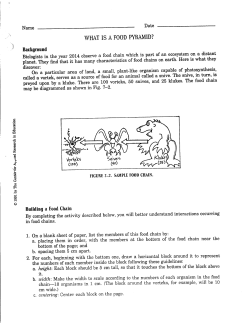
slides - University of Pittsburgh
Video: Ego-centric and Summarization Presentation: Constance Clive Computer Science Department University of Pittsburgh Nonchronological Video Synopsis and Indexing Yael Pritch, Alex Rav-Acha, Shmuel Peleg School of Computer Science and Engineering The Hebrew University of Jerusalem IEEE Transactions on Pattern Analysis and Machine Intelligence, 2008 Motivation • Effectively summarize activities from captured surveillance video • Address queries on generated database objects Approach Results • Online phase requires less than one hour to process an hour of vides (for typical surveillance video) • Queries returned on the order of minutes depending on POI (Period of Interest) Examples • http://www.vision.huji.ac.il/video-synopsis Detecting Activities of Daily Living in FirstPerson Camera Views Hamed Pirsiavash, Deva Ramanan Department of Computer Science, University of California, Irvine *slide courtesy of Piriavash and Ramanan Motivation • Tele-rehabilitation • Life-logging for patients with memory loss • represent complex spatial-temporal relationships between objects • Provide a large dataset of fully annotated ADLs Challenges long-scale temporal structure “Classic” data: boxing Wearable data: making tea Start boiling water Do other things (while waiting) Pour in cup Drink tea time Difficult for HMMs to capture long-term temporal dependencies *slide courtesy of Piriavash and Ramanan Features • Identify object: t = particular frame i = a single object p = pixel location and scale T = set of frames to be analyzed • Aggregate features over time: Temporal Pyramid • Generate temporal pyramid = a histogram over a video clip j = depth of the pyramid (level) • Learn SVM classifiers on features for activity recognition: Temporal pyramid Coarse to fine correspondence matching with a multi-layer pyramid Inspired by “Spatial Pyramid” CVPR’06 and “Pyramid Match Kernels” ICCV’05 SVM classifier Video clip Temporal pyramid descriptor time *slide courtesy of Piriavash and Ramanan Active Object Models • How to tell that an open fridge and a closed fridge are the same object? • Train an additional object detector using the subset of “active” training images for a particular object “Passive” vs “active” objects Passive Active Dataset • 20 people • 30 minutes of footage a day • 10 hours of footage per person • 18 different identified ADLs ADL vs. Image-Net Annotation • 10 annotators, one annotation per 30 frames (1 second • • • • Action Label Object bounding box Object identity human-object interaction • For co-occurring actions, the shorter interrupts the longer Annotation Functional Taxonomy Experiment • Leave-one-out cross-validation • Average precision • Class confusion matrices for classification error and taxonomy-derived loss Training • Off-the-shelf parts model for object detection • 24 object categories • 1200 training instances • Inherent differences between training datasets: Action Recognition results Space-time interest points (STIP) Bag-of-objects model (O) Active-object model (AO) Idealized perfect object detectors (IO) Augmented Idealized object detectors (IA+IO) Discussion • Limitations? • Future Work?
© Copyright 2025

















